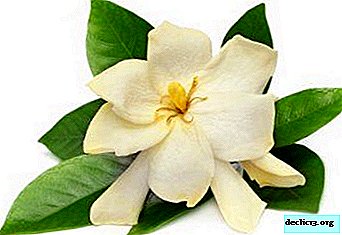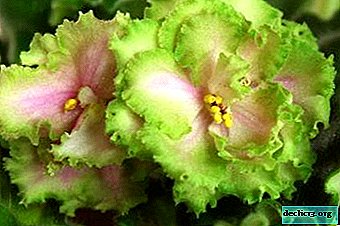Exquisite magnificent beauty azalea pink - description, photo, nuances of care

Pink azalea is the most delicate and sophisticated flower with a delicate aroma. Due to the branching and density of the crown, it can be mistaken for a decorative tree.
This variety of azalea has its subspecies, as well as the nuances in the care and cultivation.
So, in this article you will find out what pink azalea looks like, see photos and subspecies, and also read how to properly care for and reproduce it.
What kind of flower is this?
Definition
Reference! Pink azalea belongs to the flowering shrubs from the genus Rhododendrons of the large Vereskov family. Pink azalea grows in a bush with many branches, small and medium-sized leaves. Feature - very magnificent flowering.Pink azalea - in translation this flower means "pink tree". Azalea is from Asia, Japan, China, and North America. Azalea flowers come in many different shades of pink.:
- pale pink;
- deep pink;
- mixes pink - white, etc.
You can find out what other shades of azaleas are in this article, and here read about the magnificent white variety of this plant.
Appearance
Pink azalea is considered a perennial - an evergreen shrub that grows long enough. Adult pink azalea is 10 years old. In its homeland, in natural conditions, pink azalea grows to 2 - 2.5 m in height. The climate features of our regions allow us to achieve only meter growth.
Pink azalea blooms very luxuriantly, but the average flowering time is up to 1, 5 months. Different varieties and sub-grades of this type of azalea have different sizes, shapes, colors of the flowers themselves:
- terry;
- brilliant;
- half-terry, etc.
Pink azalea can have a flat, tubular or funnel-shaped bell shape. The sizes of inflorescences are small and medium, large, double flowers - "giants".
Pink azalea is distinguished by delicate tones of pink color - from a colorful shade to pale pink, pastel. Most subspecies of pink azalea blooms so generously that it covers with flowering leaves and twigs. Timely pruning of old branches and young shoots forms a regular and flowering bush.
Pink azalea grows slowly but compactly. Young shoots are highly branched, they need to be thinned out every year so that flowering is plentiful, and young shoots develop freely.
Important! The leaves are relatively small, grow to 2.5 - 3 cm. In their structure, they are smooth, covered with a natural gloss - gloss, dense, elongated, oblong, lanceolate. They have a bright, deep, dark green color.Description and photos of varieties of azalea
Next, you can see a photo of rhododendrons with the name and description of pink varieties.
Pink lights
 Belongs to stunted shrubby bushes. The variety is distinguished by the brightness of the color of the flowers themselves - saturated pink, decorated with a dark bard shade of the upper petal. The crown is dense, reaching a diameter of 1 m. The bush can grow tall up to 140 - 150 cm. The flowers themselves are medium in size, 3.5 - 4 cm in length. It is characterized by good frost resistance and can withstand temperatures lower than 30 - 35 ° C.
Belongs to stunted shrubby bushes. The variety is distinguished by the brightness of the color of the flowers themselves - saturated pink, decorated with a dark bard shade of the upper petal. The crown is dense, reaching a diameter of 1 m. The bush can grow tall up to 140 - 150 cm. The flowers themselves are medium in size, 3.5 - 4 cm in length. It is characterized by good frost resistance and can withstand temperatures lower than 30 - 35 ° C.
Elegant
 This azalea is distinguished by interesting and voluminous inflorescence brushes. Each inflorescence combines up to 15 - 20 pink flowers. Petals are curly, have a lilac - lavender hue. The bush grows to 2 m in adulthood. Growing slowly. In summer and spring, it attracts insects, butterflies and bees with its aroma.
This azalea is distinguished by interesting and voluminous inflorescence brushes. Each inflorescence combines up to 15 - 20 pink flowers. Petals are curly, have a lilac - lavender hue. The bush grows to 2 m in adulthood. Growing slowly. In summer and spring, it attracts insects, butterflies and bees with its aroma.
Mikrantum
 In literal translation from Latin, the variety means "small-flowered" - the flowers differ in expressive, densely pink color, but small in diameter - up to 3 cm. The crown is spacious, grows in a hemisphere, dense. The leaves are shiny, small - up to 3 cm, very dense, glossy.
In literal translation from Latin, the variety means "small-flowered" - the flowers differ in expressive, densely pink color, but small in diameter - up to 3 cm. The crown is spacious, grows in a hemisphere, dense. The leaves are shiny, small - up to 3 cm, very dense, glossy.
Elsie Lee
 This variety is distinguished by a motley color of the flowers themselves: soft purple petals with delicate pink dots. Terry flowers, large, in diameter up to 8 - 9 cm. Leaflets are light green, medium length, oblong. The bush is sprawling, the crown is loose. It grows with a free bush, in width and in height up to 80 cm. It feels better in a secluded place protected from the wind. This variety tolerates winter well.
This variety is distinguished by a motley color of the flowers themselves: soft purple petals with delicate pink dots. Terry flowers, large, in diameter up to 8 - 9 cm. Leaflets are light green, medium length, oblong. The bush is sprawling, the crown is loose. It grows with a free bush, in width and in height up to 80 cm. It feels better in a secluded place protected from the wind. This variety tolerates winter well.
Breeding History
Pink azalea is a young flower; its history began at the beginning of the 20th century. Then this species was called Kurum azaleas. But due to the peculiarities of care, inability to climate, frost and wind, azalea did not take root in the gardens of Europe and America.
But thanks to the efforts of breeders, after some time, pink azalea hybrids appeared that feel great all year round in our gardens and front gardens.
Growing recommendations
Care
In autumn and winter, the ideal temperature for pink azalea is 12-14 ° C during the day and 6-8 ° C at night. Humidity should be high. Azalea does not tolerate dry air.
Important: It is undesirable to place the plant in a tube or pot on window sills near batteries, which during heating very dry the substrate and air.In autumn and winter, due to the short daylight hours, additional lighting is required for several hours a day with special phyto lamps. Pink azalea begins to bloom in winter, early varieties begin to bloom in December. Later varieties bloom at the end of winter or in March. Flowering is lush, bright, but not long.
- It is necessary to clean the pink azalea from dry inflorescences and leaves in a timely manner.
- When young shoots appear - shoots, be sure to pin the top. For the first time in May, in the summer, plucking repeat 2-3 times.
It is the pinch that forms the tree with a beautiful, lush, dense crown. Before and after flowering, azalea prefers a cold shower..
Top dressing
 Fertilize pink azalea in spring and summer once a week with special fertilizers for azaleas. You can use a solution of nitrate and potassium sulfate - 14-17 g per 8-9 liters of water. For uniform absorption of fertilizers into the substrate, fertilizing is best combined with watering.
Fertilize pink azalea in spring and summer once a week with special fertilizers for azaleas. You can use a solution of nitrate and potassium sulfate - 14-17 g per 8-9 liters of water. For uniform absorption of fertilizers into the substrate, fertilizing is best combined with watering.
When laying the kidneys, pink azalea can be fed with a solution of superphosphate, the doses are not increased. It is necessary to observe proportions so as not to overfeed the flower - buds may crumble.
Mineral fertilizers for pink azalea are contraindicated - they have a lot of salt, a white coating appears inside the pot.
Landing
It is important to transplant young pink azalea every year, and an adult enough every 3 to 4 years.
Important: During flowering, a transplant is not desirable - there is a risk that the flower will not take root.The best time for planting is after flowering, when young shoots have appeared - shoots.
It is important to follow the procedure for transplanting pink azalea:
- Expanded clay drainage is poured into the pot, at least 3-4 cm.
- It is necessary to soak the substrate well in order to easily remove the flower from the old pot.
- Gently remove the azalea from the previous container.
- In a basin of water, the root sinks along with an earthen lump for 30 to 40 minutes.
- It is important to remove the old substrate by washing it with a watering can.
- Use only purified water at room temperature.
- It is important to clean the root of infected and dried roots.
- The renewed pink azalea is placed in a new, more spacious pot and covered with a pre-prepared substrate on the root neck.
- For top dressing the root system, it is advisable to use a solution of zircon.
- Regular top dressing can be started no earlier than 1.5 - 2 months after transplantation.
If the old substrate has not caked and is not infected with fungus or pests, it is recommended to transplant pink azalea by transshipment. With this, the movement of the flower into a new pot, along with the former earthen lump, undergoes a soft habituation to the new conditions, pink azalea will quickly and painlessly take.
Breeding
 The substrate should be acidic and loose.
The substrate should be acidic and loose.
The composition of the substrate:
- Sod or leaf land - 2 parts.
- Sand - 1 part.
- Horse peat - 1 part.
- Coconut threads, so that the substrate is loose and does not cake - 1 part.
If there is no heather or turf land, you can take pine land in the forest or on personal plots where conifers and bushes grow. The pot can be taken low, spacious of any material.
In apartment conditions, pink azalea is usually propagated by cuttings:
- Cut shoots to 10 cm.
- Remove kidneys and leaflets from the handle.
- The slice must be treated with any growth stimulator.
- Planted cuttings in a shallow pot.
- Holes are made in the pot to drain the water.
- Pots must be placed in a bright, warm place - at least 18 - 20 ° C.
- Seedlings are covered with film or glass, form a small greenhouse.
- Ventilate regularly - 2 times a day.
- Usually shoots take root within a month.
- New leaflets appear.
- After a month, young shoots are planted in open ground or containers.
Pests and diseases
The most common diseases of pink azalea:
- Late blight - rot the root. The disease spreads to the branches, and then to the leaves. Save the pink azalea by spraying the leaves with a phytoerm solution.
- Necrosis pink azalea begins to hurt from a sharp hypothermia and drafts. Leaves turn brown. Immediately adjust the temperature and move the pots to a bright place.
- Chlorosis pink azalea leaves appear due to the influence of hard water, inappropriate soil composition. When watering, it is better to acidify the water. You can fertilize the flower with iron chelate.
Dangerous pests of pink azalea:
- Rhododendral Bedbugs - The main pests of pink azalea. Ugly spots remain on them from the leaves. Bedbugs lay eggs on the inner surface of the leaves. Urgent treatment with a diazinan solution will be required.
- Spider mite braids with a thin web of stems, branches and leaves. The tick feeds on the juice, the leaves become brown - gray in color, and then fall off. Washing the leaves with a soap solution will help. With a more advanced stage of damage, it is necessary to spray the leaves with an actellic solution: 2 - 3 ml per liter of water.
- Azalea Moth quickly spins the leaves into a straw. As a result, the leaves dry and then fall off. Caterpillars quickly spread to healthy leaves, destroy them. Urgent treatment with sulfur will help.
- Mealybugs deform pink azalea leaves, affect young stems and flowers. Need a warm shower and spraying with an insecticide solution - 1 - 2 ml per liter of water.
Pink azalea is a finicky flower, it needs special care, proper watering and a fairly high humidity. The flower is susceptible to diseases and garden pests.. But the efforts and efforts will be paid for by the elegant bloom of pink azalea.

















